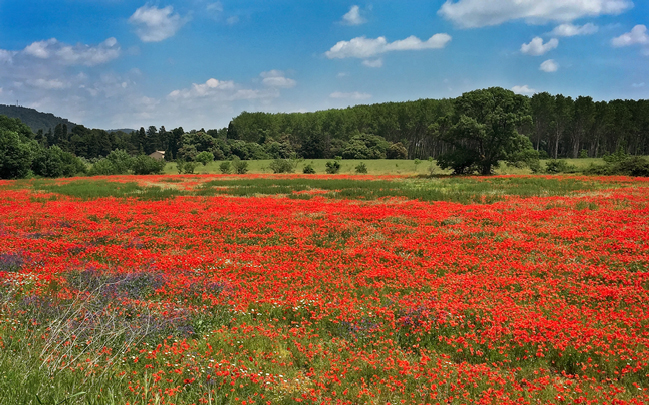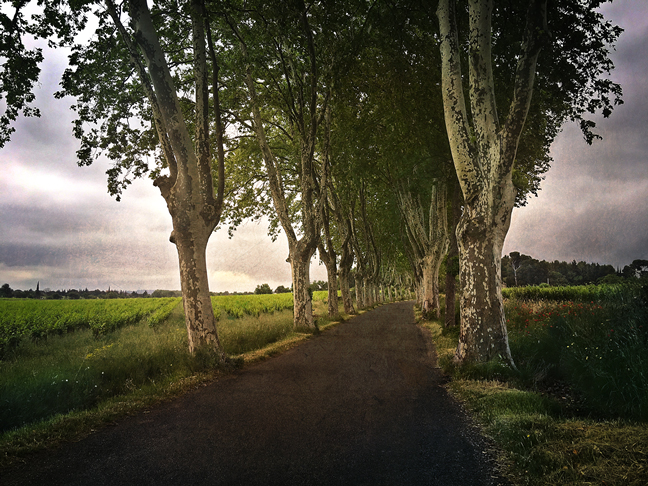It has taken longer than I imagined it would to get this blog going, but ta da! Here we are!
SEEING RED. I wrote the last post a month ago, and I’m happy to report that the poppies have been eye-popping this spring. I’ve never seen anything like this show they’ve been giving us, and it just keeps going. We have had a rainy and cool spring, and the poppies appear to be quite pleased about that. A short distance from Bize, there’s a field that I drive past nearly every day. It has looked like this for about three weeks:
EATING RED. To continue the red theme, here’s a photo of what has been tempting my taste buds lately. Local strawberries—of many varieties—have shown up, and I cannot resist. But then, who wants to try resisting such scrumptiousness? I bite into one of these little morsels of deliciousness, and inside my mouth there’s an explosion of what I can only describe as strawberry perfume. It’s voluptuous, it is sweet, it is utterly and completely strawberry: one of the basic flavors of sunshine.
GREEN LIGHT. I know, it seems a bit like Christmas to jump from red to green, but those seem to be the two dominant colors at the moment. With all the rain and cooler weather we’ve had this spring, the greens are rich, vibrant, and yes, saturated.
I love to drive, and two local drives in the past few days have led me to some fine views of green. The first was on my drive home from one of the myriad local vide-greniers (attic sales) that occur every weekend in different towns across the region. As I passed through a tiny neighboring town, I saw a sign pointing toward a Roman fountain. This is just the sort of thing that grabs my attention, and I wondered just what a Roman fountain might look like, and did they really mean those Romans? Suddenly I was upon it, and nabbed a handy parking spot. Walking a few paces down a hill, I arrived to see a fountain that had, in fact, been constructed by some Romans living in the region around 2,000 years ago. It’s in a rocky area and is overhung by the cliff above. They built a wide trough to catch the fresh water that still seeps through the rock, drip, drip, drip. Water that has nourished man and beast through all those years.
GREEN TUNNEL. The next day, driving in a different direction, I made my way along one of my favorite local stretches of road. Two hundred years ago, Napoleon ordered the roads of France to be lined with tall trees to provide shade for his marching troops. I adore these roads, with the tall, shady trees that sometimes meet at the top to form a green cathedral high above the road. Usually the roads are relatively straight, but this little road not far from home meanders along with a few S-curves, which makes the green cathedrals even more magical. The trees are most often plane (or platane, or sycamore) trees, but I call them Napoleon’s trees, and sometimes I stop to take pictures, which never quite capture the magic or the loveliness of the scene.
ASPARAGUS SOUP (about 4 servings)
The asparagus has been abundant, and I’ve been using this recipe for a fresh soup that can be served hot or cool. This is the very taste of spring freshness!
2 lbs green asparagus
2 onions, chopped
2 TBS unsalted butter
3-4 cups chicken broth
1/2 cup crème fraîche
dash of lemon juice
salt and pepper
- Cut tips from 12 asparagus 1″ from the top. Halve the tips lengthwise if they’re thick. Set aside.
- With the remaining asparagus, cut into 1/2″ pieces.
- Melt butter in a large heavy pot. Stir in chopped onion and cook until softened.
- Add asparagus pieces, plus salt and pepper to taste. Cook, stirring, 5-6 minutes.
- Add 3 cups chicken broth and simmer, covered, until asparagus is very tender, 20-30 minutes.
- When the asparagus is soft, turn off the heat and let the soup cool a little.
- Use an immersion blender to blend the purée the soup. If desired, add more broth to thin the soup.
- Cook the reserved tips to use as a garnish. I like to quickly sauté them in a hot skillet.
- If serving the soup hot, turn the heat back on and bring the soup just to a boil. Stir in the crème fraîche and a little lemon juice.
- Serve in bowls with a few asparagus tips on top. This soup is delicious with parmesan toasts, and I like it with a slightly sweet white wine such as gewürztraminer or a dry muscat.
Bon appetit!





This is brilliant, and I’m making the asparagus soup tonight!
LikeLike
Thanks so much, sweet one! Let me know how the soup turns out … yummm.
LikeLike
Your photos and story are delicious parts of my day to read and dream about.
LikeLike
Thank you, Pat! How fun to hear from you today!
LikeLike
And a bonne journée to you too!
LikeLike